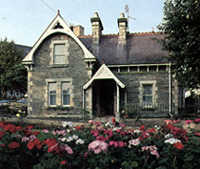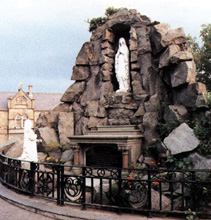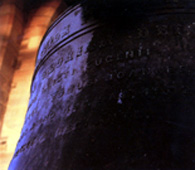 |
The
external form of the Cathedral is “Decorated Gothic”.
This is well exemplified in the western tower and spire,
the high nave ridge, the relatively low lean-to aisle
roofs, the dropping of the ridge line over the chancel
and the slight projection of the east gable beyond the
aisles.
One of the most
interesting features is the contrast between the granite
of the aisle buttresses and the grey/green stonework
between them and the granite trim of the large windows.
The trim of the clerestory windows is in sandstone.
Toye & Ashlin, architects for the belfry and spire
adhered to the basic principles of design, but they
added considerable decoration to the belfry and spire,
and also added pinnacles and statues to the east end
of the chancel and aisles.
The
Grounds
Bishop John Keys O’Doherty was the first bishop
to be consecrated in the Cathedral. When he came to
St. Eugene’s in 1890, there were only two entrance
gates - one at Creggan Street and one at the Great James
Street end of Francis Street. Two new avenues were then
constructed to give access to the Cathedral from William
Street and Great James Street. The smaller gate at Great
James Street was also added at this time. All the wrought
iron gates were ordered from the firm of Jones, Belfast.
| The Bishop’s House,
built in 1876, is constructed in the same stone
as the Cathedral. All of the bishops lived in
the house until 1988 when the bishop’s aprtments
were refurbished as diocesan offices. The priests
of St. Eugene’s parish have always lived
there.
Located at the William
Street gate is the Gate Lodge, designed by E.J.
Toye and built by the firm of Joseph Ballantine
in 1904. |
 |
The Grotto
| The Grotto was erected
in the grounds of the Cathedral in 1928 in memory
of Bishop Charles McHugh (1907-1926) because of
his great devotion to Our Lady of Lourdes, and
to commemorate the fact that he inaugurated the
first Irish National Pilgrimage to Lourdes in
1912.
The Grotto was blessed
by Bishop O’Kane on the eve of the feast
of Our Lady of Lourdes on Wednesday, 10th February
1929. |
 |
Bishop Farren’s
Grave
Prior to his death Bishop Neil Farren expressed a wish
to be buried outside the Cathedral. He died on 7th May
1980. His remians were interred at the right of the
main entrance on the 12th May 1980.
Bells
| The Cathedral’s ten
bells were manufactured by the firm of Gillett &
Johnstone, Croydon, and cost £2,145. They
arrived in Derry on 16th September 1902 and were
consecrated by Bishop O’Doherty ten days later. |
|
As a native of the city, Bishop
O’Doherty was keenly conscious of the significance
of the sound of the Cathedral bells ringing out over
the city. The bells of St. Eugene’s rang for the
first time on Christmas Eve 1902. The bells are individually
dedicated to:
The
Blessed Virgin
Saint Joseph
Saint Eugene
Saint Michael the Archangel
Saint Gabriel
Saint Patrick
Saint Columba
Saint Brigid
Saint Dympna
Saint Aloysius |
 |
The latin inscription
on the large bell reads: ‘Ad gloriam Dei et in
honoren Sancti Eugeni me fieri fecit rudmus Joannes
K. O’Doherty eps derrienis anno rep sal 1902 Leone
XIII feliciter regnante’. (‘To the glory
of God and in honour of Saint Eugene, the Reverend John
K. O’Doherty, Bishop of Derry had me made in 1902
during the pontificate of Pope Leo XIII’).
The bells chime
out a selection of hymns in keeping with the liturgical
season. The bells ring out each day at 8.00am, 12 noon,
6.00pm and 9.00pm. |
 |